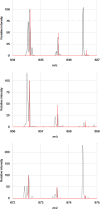Unsupervised machine learning using an imaging mass spectrometry dataset automatically reassembles grey and white matter
- PMID: 31519997
- PMCID: PMC6744563
- DOI: 10.1038/s41598-019-49819-1
Unsupervised machine learning using an imaging mass spectrometry dataset automatically reassembles grey and white matter
Abstract
Current histological and anatomical analysis techniques, including fluorescence in situ hybridisation, immunohistochemistry, immunofluorescence, immunoelectron microscopy and fluorescent fusion protein, have revealed great distribution diversity of mRNA and proteins in the brain. However, the distributional pattern of small biomolecules, such as lipids, remains unclear. To this end, we have developed and optimised imaging mass spectrometry (IMS), a combined technique incorporating mass spectrometry and microscopy, which is capable of comprehensively visualising biomolecule distribution. We demonstrated the differential distribution of phospholipids throughout the cell body and axon of neuronal cells using IMS analysis. In this study, we used solarix XR, a high mass resolution and highly sensitive MALDI-FT-ICR-MS capable of detecting higher number of molecules than conventional MALDI-TOF-MS instruments, to create a molecular distribution dataset. We examined the diversity of biomolecule distribution in rat brains using IMS and hypothesised that unsupervised machine learning reconstructs brain structures such as the grey and white matters. We have demonstrated that principal component analysis (PCA) can reassemble the grey and white matters without assigning brain anatomical regions. Hierarchical clustering allowed us to classify the 10 groups of observed molecules according to their distributions. Furthermore, the group of molecules specifically localised in the cerebellar cortex was estimated to be composed of phospholipids.
Conflict of interest statement
The authors declare no competing interests.
Figures






Similar articles
-
Cigarette Smoke-Induced Alterations in Frontal White Matter Lipid Profiles Demonstrated by MALDI-Imaging Mass Spectrometry: Relevance to Alzheimer's Disease.J Alzheimers Dis. 2016;51(1):151-63. doi: 10.3233/JAD-150916. J Alzheimers Dis. 2016. PMID: 26836183 Free PMC article.
-
Matrix-assisted laser desorption/ionisation mass spectrometry imaging of lipids in rat brain tissue with integrated unsupervised and supervised multivariant statistical analysis.Rapid Commun Mass Spectrom. 2008 May;22(10):1503-9. doi: 10.1002/rcm.3498. Rapid Commun Mass Spectrom. 2008. PMID: 18421763
-
Imaging mass spectrometry of frontal white matter lipid changes in human alcoholics.Alcohol. 2018 Mar;67:51-63. doi: 10.1016/j.alcohol.2017.08.004. Epub 2017 Aug 17. Alcohol. 2018. PMID: 29425959 Free PMC article.
-
[Imaging Mass Spectrometry in Histopathologic Analysis].Rinsho Byori. 2015 Apr;63(4):472-80. Rinsho Byori. 2015. PMID: 26536781 Review. Japanese.
-
Unsupervised machine learning for exploratory data analysis in imaging mass spectrometry.Mass Spectrom Rev. 2020 May;39(3):245-291. doi: 10.1002/mas.21602. Epub 2019 Oct 11. Mass Spectrom Rev. 2020. PMID: 31602691 Free PMC article. Review.
Cited by
-
Neuropathology of SCA34 showing widespread oligodendroglial pathology with vacuolar white matter degeneration: a case study.Acta Neuropathol Commun. 2021 Oct 24;9(1):172. doi: 10.1186/s40478-021-01272-w. Acta Neuropathol Commun. 2021. PMID: 34689836 Free PMC article.
-
Prognostic potential of lipid profiling in cancer patients: a systematic review of mass spectrometry-based studies.Lipids Health Dis. 2024 May 25;23(1):154. doi: 10.1186/s12944-024-02121-0. Lipids Health Dis. 2024. PMID: 38796445 Free PMC article.
-
Cancer Tissue Classification Using Supervised Machine Learning Applied to MALDI Mass Spectrometry Imaging.Cancers (Basel). 2021 Oct 27;13(21):5388. doi: 10.3390/cancers13215388. Cancers (Basel). 2021. PMID: 34771551 Free PMC article.
-
Advances in neuroproteomics for neurotrauma: unraveling insights for personalized medicine and future prospects.Front Neurol. 2023 Nov 22;14:1288740. doi: 10.3389/fneur.2023.1288740. eCollection 2023. Front Neurol. 2023. PMID: 38073638 Free PMC article. Review.
-
Imaging of lysophosphatidylcholine in an induced pluripotent stem cell-derived endothelial cell network.Regen Ther. 2020 May 18;14:299-305. doi: 10.1016/j.reth.2020.03.007. eCollection 2020 Jun. Regen Ther. 2020. PMID: 32462058 Free PMC article.
References
-
- Kennedy, H., Van Essen, D. C. & Christen, Y. (eds). Micro-, Meso- and Macro-Connectomics of the Brain. (Springer, 2016). - PubMed
Publication types
MeSH terms
Substances
LinkOut - more resources
Full Text Sources

